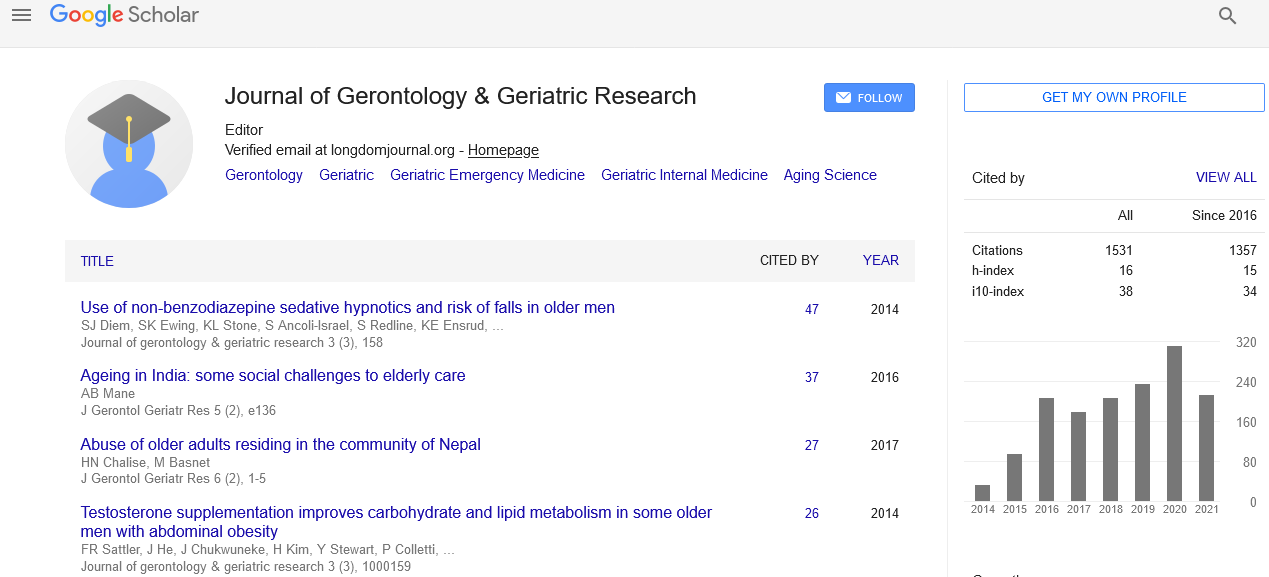PMC/PubMed Indexed Articles
Indexed In
- Open J Gate
- Genamics JournalSeek
- SafetyLit
- RefSeek
- Hamdard University
- EBSCO A-Z
- OCLC- WorldCat
- Publons
- Geneva Foundation for Medical Education and Research
- Euro Pub
- Google Scholar
Useful Links
Share This Page
Journal Flyer

Open Access Journals
- Agri and Aquaculture
- Biochemistry
- Bioinformatics & Systems Biology
- Business & Management
- Chemistry
- Clinical Sciences
- Engineering
- Food & Nutrition
- General Science
- Genetics & Molecular Biology
- Immunology & Microbiology
- Medical Sciences
- Neuroscience & Psychology
- Nursing & Health Care
- Pharmaceutical Sciences
Reframing elder abuse
International Conference on Geriatrics & Gerontology
July 08-10, 2014 DoubleTree by Hilton Hotel Chicago-North Shore Conference Center, USA
Greg Shaw
Accepted Abstracts: J Gerontol Geriat Res
Abstract:
Elder abuse, neglect and exploitation are largely hidden, shrouded in secrecy and shame. Older people are often reluctant to reveal incidents of abuse, particularly when the abuser is a family member. Adding to the problem, many health care, law enforcement, financial and aging service professionals often do not understand or recognize elder abuse, neglect or exploitation. When they do recognize the problem, they often do not know where to turn for help. Elder abuse is a growing, serious problem that exists in every community and every neighborhood, whether rich or poor. Financial abuse is the most commonly reported, however elder abuse has many forms: physical abuse, emotional abuse, sexual abuse, neglect (as well as self-neglect) and spiritual abuse. Elder abuse cases are not always bought before the courts and many mistreatments go unreported. The origin of this silence can be physical when the victim is no longer able to react to the abuse (such as elderly affected by Alzheimer?s disease) or psychological when the victim is too ashamed or too afraid to report their abuse; sometimes the victim is not even aware of being abused and for example, many financial abuses are discovered by accident or because a third party had concerns. Society itself can remain silent about elder abuse when it comes to cultural norms or traditional believes like witchcraft or mistreating a widow.
Biography :
Greg Shaw has a science and health administration background and until taking up the position of Director, International and Corporate Relations in June 2003, held senior management positions within the Australian Commonwealth Department Health and Ageing in Australia. Prior to joining the IFA he was the Manager for residential aged and community aged care programs in Western Australia. His long career with the Australian Government included management of the Compliance, Complaint and Accountability Section of the Department, having responsibility for the regulatory regime associated with quality of care and certification programs in both residential and community care services. His earlier work focused on policy development and program implementation supporting the aged care needs of rural and remote communities throughout northern Australia


